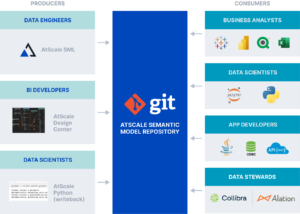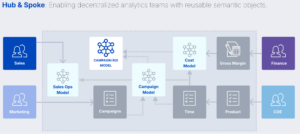Businesses increasingly turn to semantic layers to bridge the gap between raw data and insightful decision-making in the rapidly evolving data landscape. The right semantic layer can be the linchpin for achieving faster data accessibility, improving collaboration between business and technical teams, and ensuring a scalable, cost-effective approach to managing enterprise data.
However, not all semantic layers are created equal. Different platforms offer unique strengths and are tailored to specific use cases. The most valuable outcome for businesses lies in finding a semantic layer that deeply integrates with their existing tools, fosters cross-functional collaboration, and scales to meet future demands. In this blog, we’ll explore what businesses should prioritize when selecting a semantic layer and how the various options in the market compare.
Supporting Multiple Modeling Personas
Some semantic layers provide developers with unparalleled flexibility. These platforms typically offer comprehensive connectivity to various data platforms and tools, and a code-first approach allows data teams to apply best practices from software engineering to their data management processes. Features like Git integration, version control, and CI/CD pipelines appeal to technical teams who want complete control over the data environment.
These platforms are especially valuable for businesses with a strong developer focus and prioritize a tailored, custom solution built by internal teams. These platforms often accelerate productivity and offer performance optimization options, allowing data engineers to generate semantic models through code. For businesses that want open-source accessibility combined with the flexibility of cloud deployment, this type of semantic layer might seem like an ideal fit.
However, appealing to the data engineering persona is not enough. While developer-centric tools shine in terms of flexibility, they may require significant effort to maintain and extend over time. Some platforms have limited support for advanced modeling capabilities, aggregate management, and BI tool integration, making them more suited for niche use cases rather than broad enterprise adoption.
AtScale, on the other hand, is designed for collaboration, extending its capabilities to both business analysts and data engineers. By offering a unified modeling infrastructure, AtScale’s open and flexible design enables business users to create their own semantic models while allowing data engineers to define and manage these models programmatically.
Analytics engineers and other code-first data modelers have the flexibility of a markup language and automation scripts to build and maintain sophisticated data products. Meanwhile, BI developers and data analysts can use a visual canvas, employing drag-and-drop tools to construct multi-dimensional data models easily.

Semantic Object Sharing & Inheritance
SML provides a common language for all teams to collaborate seamlessly, driving faster time to insights. This balance between technical flexibility and business accessibility makes AtScale an essential tool for enterprises seeking to democratize data. With visual and code-based modeling support, AtScale enables collaboration among these personas.

AtScale’s open-sourced YAML-based Semantic Modeling Language (SML) is compatible with any development IDE, enabling seamless CI/CD integration with Git for a consistent source of truth throughout the development process.
SML is an object-oriented language that promotes composability and inheritance. This allows semantic objects to be shared within other semantic objects and across organizations, supporting easy and consistent model-building. By sharing semantic objects and supporting a hub and spoke model of data product development, AtScale allows enterprises to decentralize with strong governance, ensuring agility and consistency across teams.

Native BI Tool Compatibility and Deep Integration
For businesses heavily reliant on BI tools, the value of a semantic layer that integrates deeply with those tools cannot be overstated. Some platforms offer broad connectivity but limited native support, often only supporting an SQL interface that is incompatible with many advanced features of the BI tools. In contrast, semantic layers that deeply integrate with BI tools, leveraging native languages like DAX or MDX, allow for the full realization of the BI tool’s capabilities. For example, Power BI requires a DAX connection to enable client-side calculations for creating reports and dashboards, so SQL connectivity won’t work.
This level of integration is critical for businesses where data teams and business users work in tandem, as it enables smoother workflows and ensures that every feature of the BI tool is used. Additionally, such semantic layers can facilitate the creation of semantic objects that are shared across the organization, reducing redundant work and improving the consistency of data insights. Businesses that depend on complex, real-time analysis, multi-fact data models, or semi-additive measures will find greater value in a platform with this depth of integration.
One of AtScale’s key differentiators is its deep integration with BI tools like Power BI and Excel. Many platforms claim to support a wide variety of endpoints, but often with a “light touch” integration. AtScale, however, goes deeper—integrating directly with BI tools by leveraging their native languages (DAX, MDX, etc.). This allows AtScale users to fully utilize the capabilities of BI tools without compromising performance or features.
Advanced Data Modeling and OLAP Engine Capabilities
For businesses dealing with moderately to highly complex data environments, AtScale’s multi-dimensional engine is indispensable. Unlike other platforms that require separate, proprietary infrastructures for features like aggregations, AtScale hosts aggregates directly within your data warehouse. This minimizes data movement, enhances performance, and simplifies overall architecture.
AtScale’s advanced modeling capabilities allow enterprises to model their business with features like multi-fact modeling, many-to-many joins, hierarchies, tree-based functions, and time-relative metrics that provide far superior modeling flexibility.
Deployment Flexibility
Semantic layers that only offer a hosted deployment option are often attractive for smaller, less complex enterprises that prioritize simplicity, efficiency, and full-service solutions. However, many enterprises cannot afford to outsource their data to a software provider and trust that their data is safe and secure.
AtScale’s deployment options are as flexible as your enterprise needs. Whether it’s public cloud, private cloud, or on-prem, AtScale can be deployed in any Kubernetes-managed environment. Unlike other semantic layer platforms, which are limited to specific public clouds like AWS, AtScale can scale across multiple cloud environments or even remain entirely on-prem, providing greater control and cost efficiency.
Another critical concern for enterprises is ensuring that data remains centralized within their existing architecture—whether in a data warehouse, data lake, or cloud infrastructure. Some platforms may require separate, proprietary infrastructure to handle this process, moving data outside the primary environment and into external storage. For companies looking to maintain strict control over their data flow, this can introduce complications, both from a governance perspective and in terms of total cost of ownership. AtScale creates and manages aggregations inside the customer’s cloud data platform, eliminating security concerns and avoiding additional and uncontrollable expenses.
Superior CI/CD and Version Control Integration
AtScale’s approach to CI/CD stands out for its ease of use and seamless integration into the software development lifecycle. With Git as the source of truth, tracking changes, sharing commits, and maintaining lineage is straightforward. AtScale’s focus on simplifying the data team’s workflow enhances productivity, allowing teams to apply software engineering best practices—such as code reviews and version control—to their data management processes. By leveraging Git’s permission and authorization features, teams building AtScale semantic models don’t need to modify their software development lifecycle (SDLC) habits.
Total Cost of Ownership
AtScale keeps the total cost of ownership (TCO) in check. Other platforms often have complicated pricing models that increase as they are more widely adopted across an organization. AtScale’s straightforward, consumption-based pricing model allows businesses to manage costs effectively without hidden fees or steep increases as more users are onboarded.
- Businesses only pay for semantic objects used in an end user’s analytics application, such as Tableau, Power BI, Excel, or Looker. Businesses do not pay for semantic objects that are still in development and have not yet been deployed for testing or production use cases.
- We do not bill for data size, number of users, or number of queries. Have every employee, customer, or supplier query the AtScale Semantic Model against the largest data set you have in the cloud.
- The more deployed semantic objects you commit to using, the lower the price per object.
Balancing Control with Self-Service and Collaboration
One of the most important considerations for any business is the balance between control and cost efficiency. Some semantic layers come with complex pricing models that scale quickly as the platform is widely adopted within the organization. For businesses with long-term growth in mind, a semantic layer that provides both flexibility and predictable pricing is essential. The most valuable platforms offer scalability without escalating costs through modular deployment options or by eliminating the need for external infrastructures like proprietary storage systems.
Moreover, businesses that value self-service capabilities often find added value in a semantic layer that supports a “hub and spoke” model. In this model, business users can create their own semantic models while data engineers can programmatically manage and optimize the overall environment. This balance between autonomy and control ensures that data teams can operate efficiently without compromising governance or performance.
Conclusion: Finding the Right Semantic Layer for Your Business
The most valuable outcome for businesses lies in a semantic layer that enables collaboration, integrates deeply with existing tools, supports scalable and automated data management, and offers flexible deployment options. Whether an enterprise leans toward open-source flexibility, a fully managed SaaS platform, or a hybrid solution that balances control with cost efficiency, the right semantic layer will ultimately be the one that can grow with the business while maintaining ease of use and governance.
Ultimately, businesses need to consider not just the current capabilities of their semantic layer but also how well it will support future growth, integration with new tools, and evolving data needs. A semantic layer that can deliver on all fronts—collaboration, integration, scalability, and cost control—is what will drive long-term success in today’s data-driven world.
When compared with other semantic layer platforms, AtScale excels in several key areas:
- Deeper integration with BI tools.
- Robust support for complex data modeling.
- Flexible deployment options.
- A collaborative approach that caters to both business analysts and data engineers.
How AtScale Can Help
Whether your enterprise needs advanced OLAP capabilities, seamless integration with existing BI tools, or a scalable solution that grows with your team, AtScale delivers where others fall short. By choosing AtScale, you’re not just selecting a tool for data engineers—you’re choosing a platform that empowers your entire organization to unlock the full potential of your data.


SHARE
ANALYST REPORT